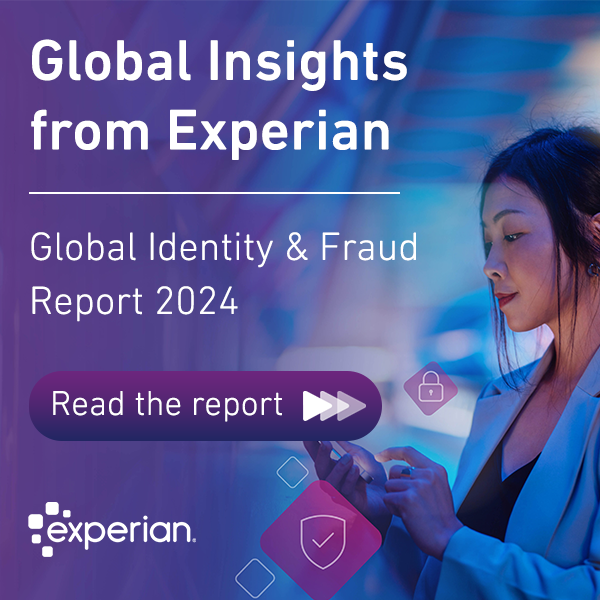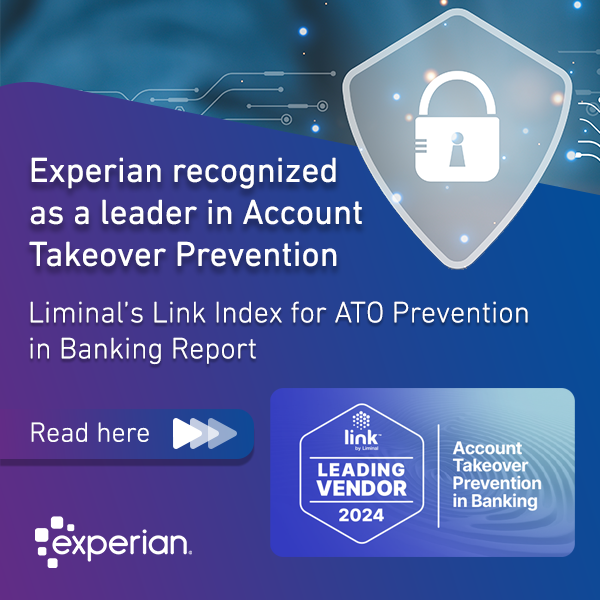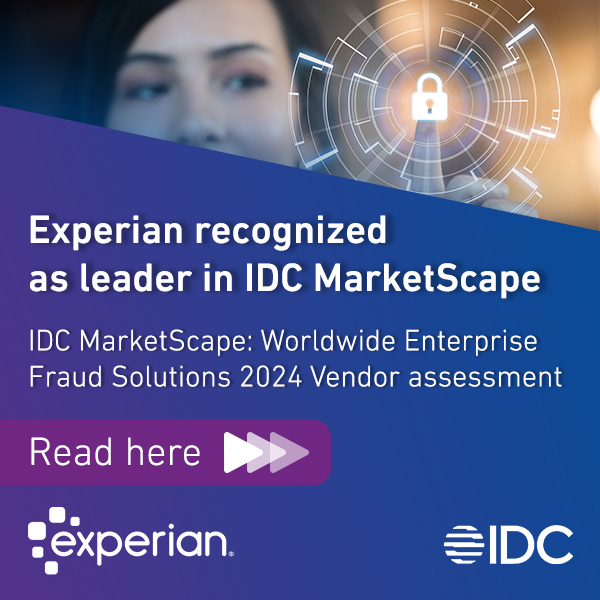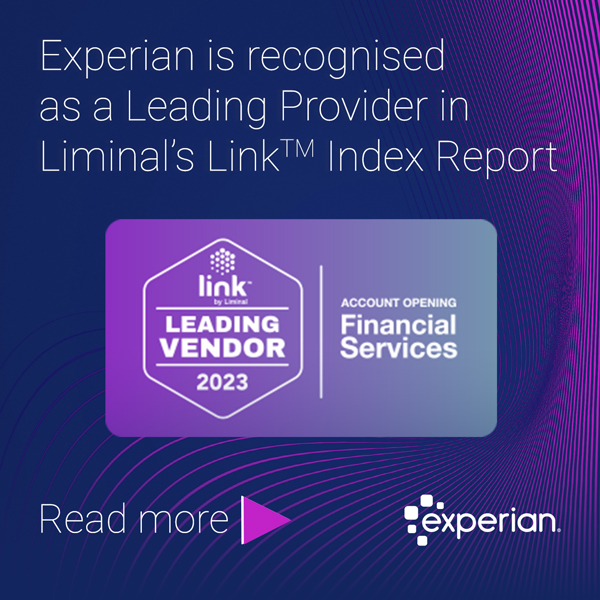All posts by Managing Editor, Experian Software Solutions

Did you miss these February business headlines? We’ve compiled the top global news stories that you need to stay in-the-know on the latest hot topics and insights from our experts. Credit card fraud jumps to a five-year high The Mail Online covers why, according to Experian, cold-calling, text scams and crypto fraud will rise in 2022, while also pointing to a rise in fraudulent credit card applications, particularly during the busy Christmas period. The future of fraud: How digital dependency creates infinite opportunity for scammers In this Forbes article, David Armano writes about the futuristic nature of Experian's Future of Fraud Forecast for 2022, and why digital transformation has created new opportunities across the fraud landscape. Your digital impression is your first impression, here's how to make it count Inc.com looks at why your digital first impression is the new first impression, and what you can do about it. Read about the four areas to focus on to put your best foot forward digitally in 2022. The markets, Ukraine, cyberthreats, and supply risks In this episode of The Tape podcast, David Britton, Global Strategy for Identity & Fraud at Experian, talks about internet fraud and how it affects consumers and businesses. Fraud suspicions have a record high in 2021 in Brazil, says Serasa Last year Brazil had 4.1 million transactions suspected of fraud, according to the Serasa Experian Fraud Index. Read about what type of fraud threats are included, and what 2022 might look like across the fraud landscape. Stay in the know with our latest research and insights:

The pandemic may have accelerated digital transformation across the world of financial services , but behind the scenes, banks and lenders still face a significant tech debt, and many organizations are committed to continuing the innovation. That's for good reason. Today's consumers increasingly expect a digital-first customer experience. The days of visiting a local bank branch to access financial services and products are fading away. Fintechs have risen to the occasion, transforming the market and meeting the growing digital demand. For traditional banks and lenders, waiting to innovate is no longer an option—it's a must to remain competitive. So what comes next? Here's a look at the technology trends that stand to impact and transform financial services as we advance. 1. The rapid rise of low-code/no-code solutions According to a recent survey from TechRepublic1, nearly half of companies are already using low-code/no-code solutions (LCNC). The same report also notes that among companies not using LCNC solutions, one in five plans to begin within the year. The driving force behind this trend is the global shortage of digital skills, from software development to data analytics to information security. The pool of technical talent has long been smaller than the demand, and the Great Resignation has only exacerbated the problem. For instance, 75% of software developers2 report they're currently looking for other jobs. Amidst this ongoing talent shortage, there's another stressor—the need to deploy technology products to market faster and faster. LCNC solutions answer these challenges by making doing so easier and quicker. The technology democratizes software development, allowing business users—or citizen developers—in different functions to design and deploy applications. With the skills gap likely to continue, the interest in LCNC solutions will too. LCNC solutions enable financial institutions to keep pace with technology changes and meet the digital demand, even with limited technical resources. 2. Leveraging data will require adding value—and engendering trust Financial service organizations have used advanced data analytics to provide consumers with more personalized products. And consumers have been on board as long as they see the benefit. For example, a 2021 consumer survey by Experian showed that 42% of consumers would share personal data, and 56% would share contact information, if it improves their experience. However, this research speaks to growing tension between consumers and financial service providers. The first want more personalized services, but they are also more selective about which companies they share data with. Consider a recent McKinsey study that revealed that 44% of consumers don't fully trust digital services3. As we advance, organizations that want to build and keep consumer trust will need to be thoughtful about the data they ask for and increasingly transparent about how they plan to use it. 3. Doubling down on AI but looking for ROI in the process AI has proven helpful in multiple ways, from powering recommendation engines and chatbots within the retail world to improving fraud analysis and prevention in the banking industry. But there's still so much more organizations can do, especially with the AI they already have. Financial service and fintech companies have funneled massive resources into AI solutions. However, only 20% of AI models4 are ever used in widespread deployment. What’s more, the current average return on AI investments hovers around 1%. This year, expect to see more organizations examining the ROI of AI-powered technology and looking to get more from the investments they've made. Technology partners can help by identifying additional opportunities for AI models to drive customer engagement, validate credit scoring, and protect businesses against fraud. 4. Banking-as-a-Service will yield even more choices and more competition There have long been high barriers that protect traditional financial service organizations from much new competition. But the advent of open APIs and Banking-as-a-Service (BaaS) is knocking these barriers down, yielding a considerable influx of startups that provide banking-like services. And this wave of new fintech has captured consumer interest. Consumers have shown that they’re willing to try financial service products from an array of providers; they're not married to sticking with traditional banks. In fact, 27% of global consumers5 have relationships with neobanks, and 40% report using financial apps6 outside of their primary banking app. However, the gold rush towards BaaS will yield a few winners and a lot of losers. The question for the near-term is who will survive in this crowded market. Consumers will also begin to figure out what makes sense in terms of how many financial organizations they want to connect with and when to say enough is enough. 5. Embedded finance is the new black in retail In a similar theme, the influx of embedded finance products into retail experiences continues to gain traction. There's only more to come. Multiple leading retailers, both longstanding and new D2C brands, have incorporated Buy Now Pay Later (BNPL) payment options into their checkout process, and shoppers are rapidly adopting these new payment methods. One-third of consumers report they've used BNPL before7. Though the payment method still lags far behind other forms of credit, awareness of BNPL and other embedded finance solutions is rising, especially among younger consumers. Looking forward, expect to see embedded finance make inroads not only with more retailers but also across other industries such as hospitality or entertainment. These pressing tech trends are reshaping financial services. In the process, they're bringing new solutions to consumers and new opportunities to banks and non-traditional lenders. Organizations that keep pace with these trends will lay the foundation for their next generation of customers as well as the future of their business. More 2022 trends and predictions Stay in the know with our latest research and insights: 1.TechRepublic Survey: Low-code and no-code platform usage increases 2.Stack Overflow: The Great Resignation is here. What does that mean for developers? 3.McKinsey: Are you losing your digital customers? 4.ESI ThoughtLab: Driving ROI through AI 5.EY: How can banks transform for a new generation of customers? 6.Axway: Consumers are starting to sense an open banking transformation 7.PYMNTS.com: No slowdown in sight for surging BNPL as consumers want it, retailers need it

Steve Wagner, Managing Director, Global Decision Analytics on Redesigning the future of consumer lending with data and analytics. Find Steve Wagner's interview in Raconteur's Future of data report to discover what businesses need to do to succeed in an increasingly digital world. “The good thing is that technology and data now allow businesses to put the customer journey at the heart of what they’re doing. With the advanced technologies available today, businesses can access relevant data and deliver on customer expectations in their moment of need. Whether it’s access to a loan or mortgage, or to consolidate debts, a real-time view of the consumer is possible.” Read the full article and find out about: Why the digital customer experience, enabled by both data and analytics, is the new battleground for many industries. Consumers reporting they were online 25% more in 2021 compared to a year before. Online retail sales saw four years of growth in just 12 months during the Covid pandemic. Demand for frictionless journeys through biometrics or multimodal authentication mean customers can see the value exchange in sharing personal data. Behavioural biometrics is the next frontier in tackling fraud and providing a seamless customer journey. Technology is allowing us to analyse far more data sources in real time, providing a comprehensive picture of an individual. Open Banking and the democratisation of data are part of the progressive change around data. Importance of extracting the insight lenders and fintech providers need to implement the best customer journey and make the best decisions. Businesses can make credit-risk decisions using automation and advanced analytics. This will lead to more opportunities for credit and better financial inclusion. Harnessing the power of 'insight everywhere' for better knowledge bases. "The application of advanced analytics, artificial intelligence and machine learning is allowing businesses to tailor their services to an audience of one - at scale." Stay in the know with our latest research and insights:

*Stats from Experian Global Insights Research Read related content The evolution of data: Unlocking the potential of data to transform our world Be more open: Results of the 2021 Open Banking survey - Experian Academy Full text: The future of consumer lending in a digital economy With the advanced technologies available today, businesses can access relevant data and deliver on customer expectations in their moment of need. As more people go online and use digital channels, your business must do more to create a seamless and secure experience. Online activity has increased by 25% globally Online retail sales saw 4 years of growth in 12 months Now online, consumers have high expectations for digital experience without sacrificing security, convenience, and privacy. 64% of consumers have abandoned an online transaction in the past 12 months Consumers, regardless of age, now prefer online banking and payments over in-person transactions The future of credit and fraud risk management is integrating data and technology seamlessly to put the customer at the centre of it all. 74% of businesses are adopting AI (2021), up from 69% the year before Businesses can embrace customer-centricity at scale through: Behavioural biometrics within a layered strategy of defence to make it easier to tackle fraud and maintain a seamless customer journey Open source data so businesses of all sizes can build a view of potential customers, minimise credit risk, and bring more people into mainstream financial services Advanced analytics, AI, and machine learning for real-time underwriting, fraud detection and a truly personalised service “The market is now driven by consumer demand for digital services. Those companies that are able to tailor the digital customer journey – so it reflects the best-in-class consumer experience – are the ones that will win.” – Steve Wagner, Managing Director of Global Decision Analytics

Steve Yin, SVP of Global Identity and Fraud Product Management, talks to Juniper Research about what it means to be recognised through Juniper Research's Future of Digital Awards for innovation in fraud detection and prevention. Watch the video to find out about: The shift in trends across fraud Impact of the increase in online traffic How those who are new to digital can be more susceptible to fraud New or expanding merchants Education for consumers on secure digital interactions What's new in fraud detection and prevention? Models to detect known types of attack vectors Predictive: new signals and awareness of emerging threats CrossCore platform capabilities Stay in the know with our latest research and insights:

Did you miss these January business headlines? We’ve compiled the top global news stories that you need to stay in-the-know on the latest hot topics and insights from our experts. Next-gen AI analytic apps in credit In this Lendit Fintech webinar about the future of AI analytics in credit, Srikanth Geedipalli, SVP of Global analytics and AI, joins a panel of experts to explain how Experian deals with delinquencies and retains customers using a proactive approach. A successful DevOps strategy is more than just technology Dr Mark D. Spiteri writes on the Forbes Technology Council about how Experian has embraced DevOps culture to not only improve internal IT processes, but also to reshape the mindset of product development teams. 7 payments trends for 2022 as innovation climbs David Bernard, SVP Global Decision Analytics, talks to Payments Dive about cross-border services, BNPL and cybersecurity tools, and how there will be no shortage of innovation and competition in the payments industry as businesses and their regulators shape new digital tools. Deepfakes – the good, the Bad, and the ugly In this Forbes article, Eric Haller, VP & General Manager, Identity, Fraud & DataLabs, talks about how the creation of deepfakes can be thought of as the latest development in the ongoing battle between business and counterfeiting. Stay in the know with our latest research and insights:

Dr Mark D. Spiteri writes on the Forbes Technology Council about how Experian has embraced DevOps culture to not only improve internal IT processes, but also to reshape the mindset of product development teams. What is DevOps? DevOps is the hybrid of development operations - a combination of software development and IT operations that shortens the product lifecycle and delivers a higher quality operational performance, benefiting the company and customer alike. The shift towards a service-centric culture As tech businesses move away from on-premises, product-centric culture, they are seeking alternatives that enable a service-centric approach. DevOps helps to do this by expanding upon agile and lean software development principles that ultimately lead to a cultural shift towards SaaS. The goal is to improve efficiency and accelerate the distribution of product enhancements, but it's all in the integration of these new ways of working. "It’s not a question if DevOps can help your company upgrade its product cycle; it’s a question of how well you can implement it into your organization." Foundations of DevOps People: Small, autonomous teams with a focus on collaboration and achieving system-orientated outcomes. Processes: End-to-end agile, lean practices for rapid IT service delivery. Technology: Automation tools that make the complete flow and pipeline of development and testing repeatable and reliable. "Improving the DevOps process can make a sea of change across every part of your product’s lifecycle, and what’s most fascinating is that the most important elements do not require a huge IT investment." Read the full article Stay in the know with our latest research and insights:

The ecosystem of credit lending platforms and technologies has rapidly grown in the past year. The top business priority emerging from the pandemic has been to prioritise investments in new artificial intelligence and machine learning models for smarter customer decisions. According to our latest report, business confidence in AI is growing: 81% up from 77% last year. Three reasons why data-centric AI models lead to more accurate and inclusive decisions More observations to better represent the population Easy o update with the most current data Enriched and expanded data sets for a complete view of the customer Stay in the know with our latest research and insights:

Interview with Donna DePasquale, EVP and GM of Global Decisioning, on winning a 2021 Bronze Stevie Award for Supporting Women and Employee Resource Groups Donna DePasquale, Executive Vice President and General Manager of Global Decisioning, has been awarded a bronze Stevie® Award in the “Women Helping Women – Business” category for 2021 in honor of her work supporting women in Decision Analytics and overseeing numerous employee resource groups across the company. She spoke about this with the Global Insights Blog. Q: Why did you think your work on helping women was worthy of this award? A: I’m a first-generation American and the first in my family to go to college. I knew since business school that I thought and acted differently from the other students, but that’s how I knew that I could add value, and that’s what I’ve always aimed to impart to other women wherever I’ve worked. I’ve been at Experian for many years and have always advocated for women at all levels of the organization. I have strived to be a mentor and championed women for growth in what is traditionally a male-dominated industry. And I’ve also tried to lead by example and with compassion. I’m a firm believer that the best results come from effective collaboration and open communication. I’ve been very lucky in my career and I’ve always been encouraged to express and share my point of view. At Experian, I try to pay that forward by encouraging all voices, and, in particular, women’s voices. Q: What did the Stevie Awards cite when you won? A: In 2018, we launched the Accelerated Development Program (ADP) to identify and mentor more women business leaders within the company. I worked with Experian’s Global Decision Analytics HR Director Richard Teague to develop this program. ADP welcomes mentees from all functions in the business. Each mentee is paired with a senior mentor who they regularly meet with for practical, on the job guidance and longer term career coaching. The mentees also participate in a variety of activities to develop hard and soft business skills. So far, the ADP has supported 44 mid-career, high-potential women on the Global Decision Analytics team in a leadership training program, and, on average, half of the women who participate are promoted within two years. The ADP complements another initiative which is important for many of our employees. We renewed our focus on DE&I in Global Decision Analytics a few years ago. We now offer five employee resource groups, which are Mental Health, Neurodiversity and Disability, LGBTQ+, Race and Ethnicity, and Gender which is focused on “Women in Experian.” These resource groups have played a valuable role for employees during the pandemic and during personal challenges. Q: Can you tell us more about the Stevie Awards? A: The awards, which are given in a range of different categories for small, medium, and large businesses, have been presented since 2002 for notable achievements in business to organizations and individuals in more than 60 nations. More on working at Experian

Mike Gross, VP of Applied Fraud Research & Analytics, takes a look at the seven top global fraud predictions for 2022. A new wave of deep fake synthetic identity fraud Fraud-as-a-Service is just a click away Real-time payments = faster fraud Fintech growth comes at a cost The two-fold reality of ransomware attacks Supply chain issues expand marketplace scams Digital identity’s convergence of identity verification and fraud detection Digital acceleration is transforming the way financial services providers connect with consumers. The rise of Fintechs, cryptocurrency, and embedded finance options from alternative lenders has changed the face of the financial services industry, and a secure but seamless customer experience has become the gold standard for businesses. Driving this demand is consumers, led firstly by a natural shift towards digital encouraged by disrupter technology providers and their easy-to-use products, and secondly by the pandemic-induced online boom. But with these changes come opportunities. And not always positive ones. As businesses grapple with how to keep up with digital demand from consumers, they are also dealing with an evolving fraud landscape, with online payment fraud losses alone set to exceed $206 billion between 2021 and 2025*. Fortunately, advancements in fraud detection and prevention methods have also accelerated, with machine learning and AI enabling businesses to keep pace with rapidly evolving fraudsters. But how have such rapid changes in the industry impacted criminal activity in this space? We look at seven key global fraud predictions for 2022. A new wave of deep fake synthetic identity fraud 2021 has seen a surge in deep fake identity fraud, and that looks set to continue. The development of AI to impersonate consumers’ voices and faces is becoming more prevalent, making it challenging for businesses to verify and authenticate identities. With recent advances in deep fake technology, fraudsters can leverage compromised identity data to bypass verification controls, and then either create new synthetic profiles with documents, facial images, and voice cloning to bypass identity authentication requirements for secure exchanges like government benefits sign ups. These deep fake tactics can impact businesses’ ability to recognize consumers across the entire lifecycle, but particularly at the point of enrolment and authentication. Detection and prevention of deep fake identity fraud involves applying a layered strategy of technical defenses along with a vigilant approach. Requiring identity data or documents in isolation is not sufficient. Organizations need to fight fire with fire by capturing digital and behavioral data to complement identity controls, then using AI and machine learning to analyze interactions and spot fraud. Fraud-as-a-Service is just a click away The use of automated bots by fraudsters to impersonate businesses and socially engineer their customers is also growing rapidly. As fraud controls become even more effective at thwarting traditional attacks, fraudsters see an opportunity to evolve their tactics and capitalize on advances in voice bots. In 2022 and beyond, a large portion of fraudulent transactions will be submitted by legitimate consumers who are being socially engineered to not only provide data, but to use their own devices to submit what they believe are legitimate transactions. Banks globally are already witnessing the start of this trend, as fraudsters can now purchase bots to contact consumers, impersonate their banks, retrieve one-time passwords, and forward those codes to fraudsters to complete fraudulent transactions. Historically, fraudsters couldn’t scale this type of attack to manage thousands of calls to consumer victims, but now they can just hire a bot that sounds and acts just like a bank reaching out to their customers. As a result of this success and the cost effectiveness of bots, fraudsters are expanding operations to impersonate every type of business, from retailers to government organizations. Real-time payments = faster fraud Faster money often means faster fraud. Real-time payments (RTP) increased by 41% between 2019 and 2020 and are set to rise again by 23% between 2020 and 2025*. From mobile payments all the way to Buy Now Pay Later, RTPs have provided ample opportunity for fraudsters to quickly monetize and cash-out – converting money to other forms of currency like crypto and then laundering the funds through multiple fraudulently-established accounts. The lack of regulation in cryptocurrency makes it an especially attractive target for fraudulent activity because attackers can more easily remain anonymous and funnel funds across currencies in mere seconds. Crypto exchange platforms have profited from the unregulated environment but are starting to pay the price when it comes to fraud losses. The speed of real-time payments presents unique challenges to businesses because they often can’t be revoked or easily traced, so detection can be more difficult. But the demand for RTP is only increasing, so consistent regulations need to be in place and organizations must be able to accurately verify and authenticate identities and transactions across channels in seconds to detect criminals preying on these faster payment methods. Fintech growth comes at a cost Buy Now Pay Later has exploded over the last year. Alternative lenders now dominate the retail landscape, embedding themselves in customer journeys, offering consumers fast and easy credit, and minimizing fraud liability for merchants. But these disruptive businesses offering tailored financial products based on vast amounts of customer data have the potential to leave the door wide open to criminals. A frictionless customer experience and easy-to-use technology has allowed these nimble businesses to attract millions of customers, and with it, huge volumes of fraud. According to Aite-Novarica Group, Fintechs have an average fraud rate of around 0.30%, which is double that of credit cards that average 0.15-0.20%. 2022 is likely the year that Fintechs put risk at the forefront of strategy. Without the right identity and fraud protections in place across their websites and apps, they not only risk fraud losses, but they could also damage brand reputation. And without quick, comprehensive fraud reporting back to the businesses they serve, they also risk enabling even more downstream fraud attacks. The two-fold reality of ransomware attacks As businesses experience extortion in the form of weaponized malware, the sophisticated nature of AI used in ransomware attacks is rapidly evolving, allowing attackers to be even more successful at extracting data and wreaking havoc. A business’s data is the primary commodity that the fraudsters use to negotiate ransom payments, but the stolen data of that business’s customers is often forgotten, which can be an even greater concern. This growth in ransomware and the availability of sensitive consumer and business data will not only drive attacks in 2022. It will likely change the nature and depth of those frauds using newly-available data such as business financials or consumer medical conditions or employment details in more pervasive attacks. Organizations falling victim to ransomware must understand all of the data that has been compromised and should notify its customers so they can take steps to prevent future identity or other fraud attacks. Supply chain issues expand marketplace scams We expect to see more issues with marketplace fraud as supply chain issues and inflation persist through 2022. Where there are supply gaps, fraudsters will meet the pent-up demand with products that don’t exist, scamming customers to part with money for nothing in return. In the current marketplace environment, it’s easy to set up a fake business with positive reviews. And because consumers have no way to verify the authenticity of a business, they roll the dice on what seems too-good-to-be-true, lose money, and then try to recoup funds from their financial provider. This is another area where BNPL providers will end up bearing responsibility for a lot of retail fraud in 2022, as they take on liability for the fraud and credit losses that fueled their rapid growth. Digital identity’s convergence of identity verification and fraud detection Password-free experiences led by the ubiquitous smartphone and the ability to make real-time payments has resulted in a demand for a seamless, uninterrupted customer journey. But central to all of this is identity authentication. As identity verification and fraud detection continue to converge, the big question is, how can a secure, consumer-friendly approach to digital identity be adopted and regulated, and by whom? The announcement of the European Digital Identity scheme shows that governments are beginning to move in this direction, but there is still a long way to go. As authentication and onboarding systems continue to be targeted by fraudsters, the bid to create secure, reusable digital identities to enable more seamless commerce and to mitigate fraud and criminal activity becomes more critical. This is a concept that is dominating the conversation and one that we expect to play a big role in fraud prevention in 2022 and beyond. *Juniper Research Stay in the know with our latest research and insights:

Did you miss these December business headlines? We’ve compiled the top global news stories that you need to stay in-the-know on the latest hot topics and insights from our experts. How are companies responding to consumer behavior? Nasdaq Trade Talk's Jill Maladrino talks to Steve Wagner, Global Managing Director of Decision Analytics, about the increase in online activity over the course of the pandemic, how inflation can impact brand loyalty, and why businesses need to respond to consumer demand with better customer experience and fraud prevention. Q&A: Why the increased use of digital transactions is here to stay David Bernard, SVP of Strategy, Marketing and Digital, talks to Digital Journal about how businesses should be approaching the increase in digital transactions using advanced analytics and decisioning technologies to improve the digital customer experience and grow their businesses. How criminals are using synthetic identities for fraud Dark Reading's The Edge talks to David Britton, VP of Industry Solutions, about why businesses must improve their fraud detection and prevention protocols to detect synthetic identities and ensure that they are protecting their consumers' personal information. Latest retail trends: AI is on the up, consumer loyalty is heading down Digital Journal looks at Experian's latest research that uncovers how businesses are incorporating machine learning and artificial intelligence into everyday operations and investments in response to an upward trend in online activity and a downward trend in customer loyalty. Stay in the know with our latest research and insights:

Transaction data is some of the most valuable data a financial institution holds. By understanding how and where customers are spending money, businesses can leverage that insight to provide exactly the right next service or cross-sell product that a customer will most likely use. With open banking, this data is becoming democratized. It allows customers to give other institutions and businesses permission to access the data, which helps mid-market lenders and fintechs compete on the same playing field as the larger banks. In addition to spurring competition and innovation, it offers the potential for greater financial inclusion to people who struggle to gain access to credit due to a lack of information on their financial track record. The impact of open banking can’t be understated. According to Accenture, it will account for roughly $416 billion in revenue across the top 20 economies once open banking is fully online. And that day is closer than you might think; a survey by Know-It revealed that 55% of UK credit providers said they plan to adopt open banking in 2021, while 93% of businesses expect to adopt the data-sharing initiative within the next 12 months. While open banking was created to give customers more control over their data, the ability for institutions to leverage shared data creates the potential for data-rich services that the industry is only starting to explore. The more that banks integrate data into their services, and the more that technology firms use data to offer financial services, the more the lines between the two will blur. The role of decision analytics in open banking The key to incorporating a successful open banking approach will be leveraging the right analytics tools for better decisions. Using real-time analytics and advanced decisioning logic so lenders can effectively leverage the data available through open banking initiatives. Here are five ways that decision analytics will enable open banking to create new credit opportunities for customers. Better risk models. Analytical models and scorecards are the lifeblood of risk analysis. Open banking makes it possible to gather far more transactional data to add to credit risk models to better understand the true risk of each customer. More accurate predictions. Transactional insight powered by open banking and decision analytics creates a deeper, fuller view into a customer’s financial profile at origination. By using advanced analytics to determine credit scoring, affordability, income verification and other factors, institutions can make more accurate predictions about how much a customer can reasonably afford to borrow and pay back when issuing credit. Fewer risky customers. By leveraging data from across institutions, lenders can also look beyond common metrics like credit scoring and income verification to dig deeper into a borrower’s background. Sophisticated decision analytics can uncover unseen red flags for a specific borrower that may require the lender to take action. Increased revenue. Looking beyond origination, open banking can help organizations leverage decisioning analytics on an ongoing basis to better understand the needs of their customers. By continuing to analyze their data, institutions can then identify more relevant cross-sell and upsell opportunities, increasing the lifetime value of the customer. They can also create customer cohorts that allow them to identify which segments will be more likely to accept specific promotional offers across the customer journey. Better customer experience. Open banking can use decision analytics to power automation so customers can get credit decisions faster. For example, an institution can leverage this ability to automatically approve credit upgrade requests from an app instead of requiring a customer to call or come into a branch. By making it faster and easier to make these types of decisions, customers will feel better about your brand and more likely to continue giving you their business. In addition, this automation reduces time-consuming tasks, allowing service staff to focus on more complex customer requests. What does it take to leverage open banking? By its nature, open banking requires large volumes of data from multiple sources so that businesses can make real-time decisions about creditworthiness and risk. Breaking down traditional data silos is central to powering analytics and increasing credit opportunities. For traditional banks relying on legacy, on-premises infrastructure to manage data, internal data silos may be a problem, limiting the use of the data available. Many of these institutions are turning to cloud solutions to reap the benefits of open banking. Cloud integrations enable automatic, daily updates and upgrades to maintain compliance. Data security is provided by the cloud vendor, not internal IT staff, so most importantly, the cloud makes it easy to reduce operational silos by connecting data through integrations, allowing businesses to maximize the potential of open banking. The future is open Open banking has the potential to revolutionize the way financial institutions and customers think about financial services. A modern decisioning solution can leverage data across the cloud to give you the power and flexibility to incorporate open banking into operations, turning complex data into actionable insight. Download the 2021 Open Banking Survey (EMEA) Stay in the know with our latest research and insights:




